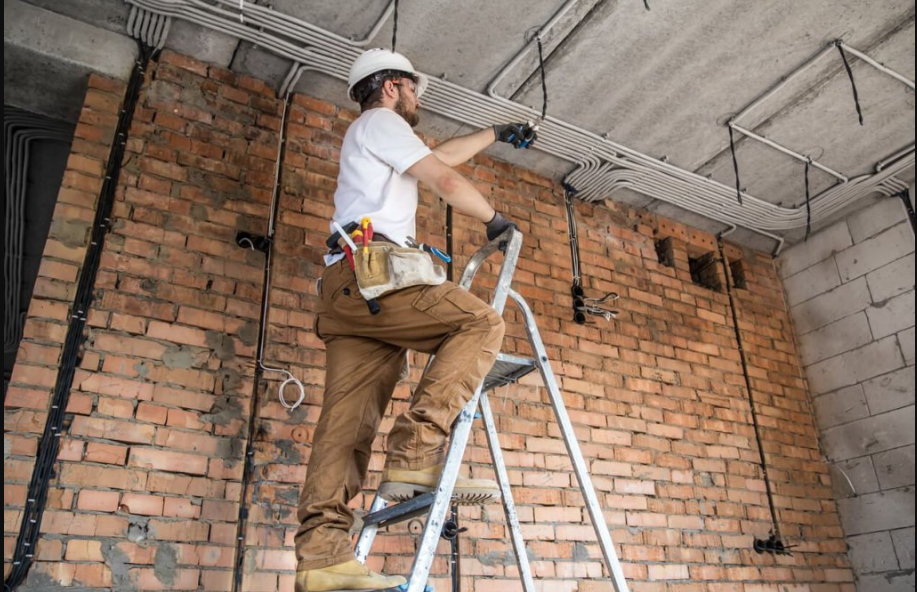Construction sites are inherently hazardous environments, and misusing ladders increases the risk of accidents and injuries. In the UK, falling from ladders is one of the leading causes of work-related injuries and fatalities, with around 14 people dying because of a fall each year.
This figure shows how vital ladder safety is on construction sites. This blog discusses the importance of ladder safety, outlining essential dos and don’ts to ensure a secure working environment.
Importance of Ladder Safety on Construction Sites:
Ladders are essential in construction. However, accidents involving them are all too common and can lead to severe injuries or fatalities. By prioritising ladder safety, construction sites can significantly reduce the likelihood of accidents, ensuring a safer workplace for everyone involved.
Ladder Safety Dos and Dont’s:
Do:
Select the Right Ladder for the Job:
Begin with the basics and choose a ladder that suits the task. Consider the height, weight capacity, and material of the ladder. Different jobs may require different types of ladders, such as step ladders, extension ladders, or platform ladders.
Inspect Ladders Regularly:
Before each use, conduct a thorough inspection of the ladder. Check for visible defects, such as cracks, dents, or loose rungs. Ensure that all hinges, locks, and other moving parts work well. Never use a damaged ladder as it significantly increases the risk of accidents.
Position Ladders on a Stable Surface:
Set up the ladder on a level and firm surface. Use levelling devices or leg extensions to ensure stability if the ground is uneven. Never place ladders on unstable surfaces or try to improvise stability.
Maintain Three Points of Contact:
Always maintain three points of contact with the ladder when climbing up or down – either two hands and one foot or two feet and one hand. This positioning provides stability and reduces the risk of slips or falls.
Follow the 4-to-1 Rule for Extension Ladders:
For extension ladders, adhere to the 4-to-1 rule. For every 4 feet of height, position the base of the ladder 1 foot away from the structure it’s leaning against. This angle provides optimal stability and prevents the ladder from tipping backwards.
Use Ladder Accessories:
Ladder accessories like stabilisers and stand-offs can enhance stability and safety. When working near power lines, use non-conductive ladders to reduce the risk of electric shocks.
Stay Within the Load Capacity:
Every ladder has a specified weight capacity. Exceeding this limit can lead to structural failure and accidents. Be mindful of the tools and materials you carry while climbing, and ensure they are within the ladder’s capacity.
Secure the Top and Bottom of the Ladder:
To prevent accidental slips, secure the top of the ladder to a stable support and use a non-slip base or have a helper hold the ladder at the bottom. This additional measure adds an extra layer of security.
Follow Proper Climbing Techniques:
Ascend and descend the ladder with caution. Face the ladder, maintain a firm grip, and avoid leaning too far to either side. Use tool belts or pouches to carry tools, keeping your hands free for climbing.
Provide Training and Awareness:
Ensure that all workers are trained in ladder safety protocols. Ladder safety training teaches workers about different ladder types, their uses, how to conduct pre-use checks, and how to safely set up and work from ladders.
Don’t:
Overreach:
Stretching beyond a comfortable reach compromises your balance and increases the risk of falling. Reposition the ladder instead of overreaching.
Use Damaged Ladders:
Using a damaged or compromised ladder is a recipe for disaster. If a ladder is defective, take it out of service and report it for repair or replacement.
Ignore Weight Limits:
Follow the manufacturer’s specifications and only use a ladder for tasks within its intended capacity.
Neglect Footing:
Placing a ladder on an unstable or slippery surface can lead to slips and falls. Avoid wet or icy surfaces, and never use makeshift objects like bricks or boards to level the ladder.
Leave Ladders Unattended:
Unattended ladders can pose a hazard to others. Always secure ladders when not in use to prevent accidental collisions or unauthorised use.
Skip Safety Gear:
Pay attention to safety gear (such as helmets, gloves, and non-slip footwear) when working on ladders.
Climb with Tools in Hand:
Keep your hands free when climbing. Climbing with tools in hand increases the risk of losing balance and falling, so use tool belts or pouches to carry equipment.
Use Metal Ladders Near Electrical Hazards:
Metal ladders can conduct electricity, posing a severe risk near power lines. Use non-conductive ladders in areas with electrical hazards and maintain a safe distance.
Rush:
Take your time when climbing and descending ladders. Rushing increases the likelihood of missteps and accidents, so always prioritise safety over speed.
Ignore Ergonomics:
Consider the ergonomic aspects of your work. Avoid prolonged periods of ladder use, take breaks, and ensure that tasks requiring extended reach are manageable without straining.
Conclusion:
Ladder safety is not an aspect of construction site management to be taken lightly. It is crucial to prevent accidents, injuries and even fatalities. Construction workers can significantly reduce the risks of ladder-related accidents by following safety dos and don’ts.
You may also like
-
The Rise of Flexible Living Spaces in UK Homes
-
Essential Tips for Setting Up a Productive Home Office
-
What Factors to Consider When Choosing Different Types of Commercial Garage Doors?
-
7 Essential Steps for UK Homebuyers Upon Moving In
-
Safety First: Operating and Maintaining Gasoline Generators for Home Use

